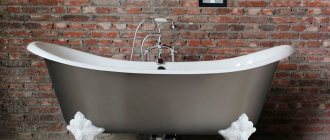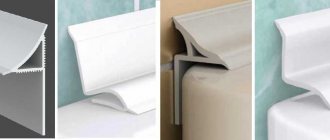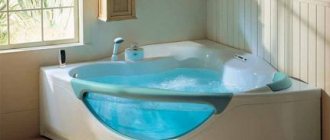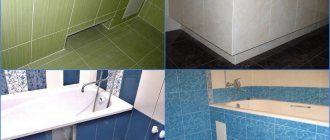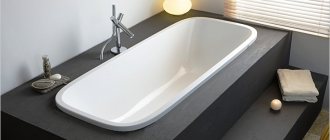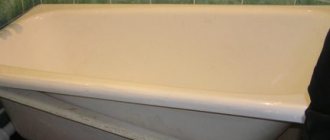A curious situation has developed in the acrylic bathtub segment: even with good theoretical training, you can buy an expensive model that will last only 5-10 years. How to choose a high-quality acrylic bathtub from a variety of models so that it pleases the eye for a very long time, is comfortable during water procedures, and at the same time costs an amount acceptable for the family budget, and let's talk. To do this, the editors of the StroyGuru website have summarized information on the selection criteria for hot tubs and manufacturers, and also compiled a rating of the best models.
No. 1. Acrylic baths: advantages and disadvantages
We'll talk about production technology a little later. First, let's find out the main advantages of acrylic bathtubs:
- light weight and easy to transport;
- a huge variety of shapes and sizes . Traditional rectangular and oval, round and corner, with lighting or hydromassage – acrylic bathtubs are available in a wide range, so you can choose the right product for a bathroom of any size. Moreover, at the production stage, the acrylic mass can be painted in the desired shade - we get a crazy assortment;
- acrylic retains heat , so the water in such a bathtub will cool slower than in cast iron or steel, by about 10C per 30 minutes;
- good sound insulation properties . If you were annoyed by the noise of water filling a steel bathtub, now your nervous system can rest - acrylic dampens noise well;
- smooth, pleasant surface that is easy to clean;
- excellent antibacterial properties. Mold will not appear on such a bathtub;
- sufficient strength, ease of restoration.
Now about the disadvantages of acrylic bathtubs :
- the cost is slightly higher than for cast iron and steel bathtubs;
- acrylic is inferior in strength to cast iron, so when installing it, you can’t do it with legs alone - you need a frame that will additionally support the bathtub and take on the load from the water and the bathing person;
- falling heavy objects can damage the surface of the bathtub;
- It is not recommended to use abrasive detergents - scratches may remain on the bathtub;
- Acrylic is not very resistant to high heat. We are talking about a temperature of +1600C, but under normal operating conditions this drawback will not manifest itself.
The durability of an acrylic bathtub depends on many factors. A high-quality, albeit not the most expensive, sample can withstand active use for 10-12 years, and with proper care - even more.
It is difficult to say which bathtub is better, acrylic or cast iron, since much depends on the budget and the requirements put forward. If you don’t need sophisticated forms, and the budget for purchasing plumbing fixtures is small, then you can opt for the cast-iron option, but today such bathtubs are still being massively replaced by more modern acrylic ones.
Pros of why consumers choose cast iron
- The first and perhaps main reason is durability. The mechanical strength of the material used plus the chemical resistance of the enamel to almost all types of cleaning agents make this choice attractive. If treated with care, a cast iron bathtub will last as long as you want.
- The second reason is that the low thermal conductivity of cast iron and its high heat capacity keep water poured into a cast iron bathtub hot for a long time. Thick walls accumulate the heat of hot water and then gradually release it back, allowing the bather to soak longer.
- The enamel used to coat cast iron is highly durable, smooth, its colors are rich and bright, the enameled surface is shiny and gives the structure an overall elegant look. The absence of pores on the enamel surface makes it easier to remove dirt.
- Another distinctive feature of cast iron bathtubs is their large mass. Even the most modern lightweight models weigh at least 100 kg. This is not always convenient, but such a large weight also has positive aspects - cast iron bathtubs are extremely stable and usually do not require any additional strengthening measures during installation. In addition, thick walls muffle the sounds of flowing water, without requiring additional sound insulation.
No. 2. Technology and material for making an acrylic bathtub
The technology for producing acrylic bathtubs is quite simple. The acrylic sheet is heated to a temperature when the material acquires good ductility and fluidity. Then it is placed under a press, which forms the shape of the bathtub. The reverse side of the bath is reinforced with a composite; polyester resins with fiberglass, or polyurethane, are often used. After this, all the necessary holes are drilled.
Acrylic bathtubs today refer to two different types of products , which are made from different materials:
- Bathtubs made of cast acrylic are the best option . Such products are created on the basis of polymethyl methacrylate . The compound is poured into sealed molds and undergoes polymerization in steam ovens. Such bathtubs are very strong, wear-resistant and durable, lasting at least 10-12 years. Additionally, the acrylic bowl receives a reinforcing base;
- bathtubs made of co-extruded acrylic , or two-layer plastic, ABS/PMMA . ABS is acrylonetrile butadiene styrene, an elastic plastic that forms the base of the bathtub and makes up about 90% of its mass. PMMA is the already familiar polymethyl methacrylate, also known as acrylic, of which there is only 5-10%. Such baths also receive a reinforcing base. They are produced by simultaneous extrusion and combination of melts of two substances. ABS plastic has a porous structure, so it can absorb moisture to a small extent. If such a bathtub is used frequently, the base will quickly collapse. The thin acrylic layer also wears off quickly, so the durability of such bathtubs is low.
At first glance, it is obvious which bath is better to choose. Of course, the one made from cast acrylic, even if it costs more. This is true in cases where you select plumbing fixtures for an apartment or house where you live permanently. For a country house with seasonal living, you can safely take a bathtub made of ABS/PMMA - the savings will be noticeable, and wear and tear under variable loads will not be catastrophic.
Conscientious manufacturers and sellers will always honestly say what material a particular bathtub is made of. But what to do if doubts creep in and you want to make sure that you are not being deceived? Everything is simple - just count how many layers the bathtub is made of , and to do this, look at the edge on the side. A bathtub made of cast acrylic will have only two layers: acrylic and a reinforcing base. A cheaper option made from co-extruded acrylic is distinguished by the presence of three layers: acrylic, plastic and base.
What's better
As you understand, the most expensive containers are made using injection molding technology. They have a long service life and are easy to care for. Some manufacturers give them a 10-year warranty (subject to installation and maintenance recommendations). This is an excellent choice, but not everyone can afford such baths. A good option is bowls made of sheet acrylic. They are quite reliable and have a relatively low price. Both options are good because if scratches or chips form, they can be repaired. Scratches are polished, and chips are filled with repair compound.
Composite bathtubs are the cheapest segment, but they cannot be repaired. Chips and scratches will remain forever. There is one more point: when using cheap acrylic, the surface becomes porous and dirt gets clogged into the pores. It is very difficult to remove it, because strong agents cannot be used. So it is difficult to maintain such bathrooms. Even if the acrylic layer does not crack, they quickly lose their appearance.
Chips may appear, but they can be repaired
If you want to choose a good quality acrylic bathtub, take the time to go to exhibition centers to see and touch samples from different manufacturers. When inspecting, pay attention to the thickness of the walls. On the cut in the area of the sides you can evaluate how well the container is reinforced, and the thickness of the acrylic is also visible here. When inspecting, estimate how much the declared thickness of the acrylic layer corresponds to reality.
If you have chosen several brands, inquire about certificates before purchasing. Serious companies provide acrylic paper and also certify their products according to European and international standards. The presence of such papers is one of the signs of the seriousness of the campaign, and their absence is a reason to wonder whether you are about to buy a fake.
No. 3. How thick should an acrylic bathtub be?
We will not surprise anyone if we say that the thickness of an acrylic bathtub and its durability are directly proportional . You can evaluate the thickness of a particular sample right in the store by looking at the end of the bathtub rim. Thickness ranges from 2 to 6.5 mm:
- products with a thickness of 2-3 mm are the cheapest, but are durable for 3-4 years;
- bathtubs with a thickness of about 4 mm under constant loads can last about 7 years;
- bathtubs with a thickness of 5-6.5 mm are long-lived and can last 10-12 years.
Sometimes you can find samples about 8 mm thick . They are expensive, and it is not easy to give them complex shapes. However, it often turns out that it is not acrylic at all, but several layers of plastic.
Brand overview
TRITON : Russian company working with Austrian acrylic sheet “SENOSAN” (4 mm thick). Antibacterial coating “ANTIBAK” is used.
- Advantages: ease of cleaning, long-term heat retention and silent filling with water. The models have non-standard sizes, which allows them to be placed in a designer bathroom.
- Disadvantages - wears out quickly, gets scratched. If you accidentally drop pumice on the surface, there is a risk of leaving marks.
Triston
ROCA : a Spanish company specializing in the production of inexpensive and elegant models.
- Advantages – can withstand up to two years of use in its original form. It is very mobile, its small size makes it easy to transport if you move.
- Disadvantages - since the bathtub is covered with an anti-slip coating, the surface appears dirty.
Roca
RADOMIR : Russian manufacturer using premium Austrian acrylic from Senoplast and European fittings.
- Advantages - the bath is stable, its assembly is neat. There are no glue or silicone stains on the seams. The hydromassage engine is installed on rubber shock absorbers, therefore it practically does not vibrate. There is a protective device against power surges.
- Disadvantages - high price.
Radomir
KOLO : Polish company practicing unusual product design. Any bathtubs are on sale: corner, sector-shaped, barrier-free.
- Advantages: Seven-year warranty on all products. The models are designed to meet the needs of different population groups.
- Disadvantages - not noticed.
Kolo
JACOB DELAFON : French manufacturers of elegant bathtubs are successfully experimenting with Flight material.
- Advantages: ease of bathing and mobility. Coating with antibacterial properties.
- Disadvantages - delicate coating, the bathtub quickly becomes covered with scratches.
Jacob Delafon
No. 4. Pay attention to the reinforcing layer
If acrylic bathtubs were made without a reinforcing layer, they would not withstand heavy loads. Many people are accustomed to evaluating different bathtub samples, so to speak, from above, looking at the snow-white acrylic and analyzing the dimensions. It also doesn’t hurt to look “under the body” and look at the reinforcing layer. There are few options for its implementation:
- a layer of polyurethane , which is dark in color, has sufficient strength, is environmentally friendly and odorless. This is ideal for a bath;
- a layer of a mixture of ester resins and fiberglass is inferior in strength and has an unpleasant odor, which manifests itself when heated to high temperatures. This reinforcement has a rough surface and sharp edges, so during installation you must be especially careful not to get hurt.
The reinforcing layer should not be thin. This can again be assessed by the end of the side. However, some cunning sellers deliberately make the sides thicker, knowing that buyers who are knowledgeable and savvy in matters of choosing an acrylic bathtub will definitely look at the ends. The rest of the bath receives a thinner layer of reinforcing layer, so it doesn’t hurt to carry out additional experiments. You can lightly press the bottom of the bathtub and its walls with your hand: normally, the material should not sag.
For another check, you will need a flashlight or laser pointer. It is necessary to lean the switched-on flashlight against the bottom of the bowl and look from the back to see if the light penetrates. You can fold your palms and look into the hole formed between them to assess as accurately as possible whether some of the rays pass through the material. A sufficient layer of acrylic and reinforcement will not allow a drop of light to pass through. Remember that the thickness of the reinforcing layer must be uniform throughout the entire bathroom.
What strength is suitable?
Acrylic bowls have low strength because they are made of flexible and pliable plastic. To strengthen, a reinforcing layer with epoxy is applied to the outside. The more layers of reinforcement, the stronger the acrylic bathtub becomes.
Polyester resins strengthen the acrylic sheet. In order to make the structure even more durable, it is appropriate to use a reinforcing metal frame and bottom or reinforced chipboard. Due to its light weight, this plumbing fixture allows for simplified transportation, installation and dismantling during repairs. The weight of the bath is thirty kilograms, and the cast iron product weighs 80-150 kg.
No. 5. What should be the surface of an acrylic bathtub?
The internal surface should be smooth, glossy and free of flaws in the form of scratches, bumps or roughness. All these defects are a sign of a fake or a very low quality product that is unlikely to serve you faithfully for ten years.
Experts advise checking the quality of the surface by pressing your palm against the walls of the bathtub. The palm seems to stick a little to a perfectly smooth surface (a mirror is the best example), so with good acrylic there should be approximately the same effect.
No. 6. Acrylic bathtub size
In terms of size, it’s more difficult to give advice. Everyone, when deciding which acrylic bathtub to choose, must take into account the size of the bathroom and their own requirements for the comfort of water procedures. The main thing is that the product is comfortable for all family members.
You can focus on the following ergonomic tips:
- the side of the bath should be located at a height of 65-70 cm from the floor. Adults, teenagers, and children can easily get into such a bathtub;
- the depth of the bath (the distance from the bottom of the bowl to the overflow hole) should be 50-60 cm. If the bath is shallower, the water may not cover the entire body; if it is deeper, you will have to hold your head awkwardly so as not to choke;
- the width sufficient for one person of average build is 75-80 cm, but there are a lot of wider products on sale;
- length usually ranges from 120 to 180 cm and can be even longer. The choice depends on the height of the family members and the available space in the bathroom. A bathtub 120 cm long is very inconvenient; in a bathtub 150 cm long, the knees of tall people will be bent, and a product 165-170 cm long with a headrest is perfect for people with a height of up to 180 cm.
On sale you can find simply gigantic bathtubs that can accommodate 2 or even 3 people at the same time. Such luxury costs a lot of money, and it cannot fit in every home.
No. 7. Shape and color of acrylic bathtub
Unlike cast iron, acrylic allows you to create bathtubs of almost any shape. The most common baths are:
- rectangular is a classic that will be appropriate in almost any bathroom. Such products are quite convenient, but many may accuse them of being simple;
- oval bathtubs are also a fairly common option; they look more interesting than rectangular bathtubs, in terms of convenience and compactness they are on par;
- round bathtubs look very impressive, they have decent dimensions, but there will be enough space for swimming. Such products will decorate the bathroom, but will be appropriate only in fairly large rooms;
- Corner baths allow you to use every square centimeter of the room to your advantage. In addition, they look very good, but due to the increased width in the corner area, some problems may arise during washing;
- asymmetrical bathtubs of complex shapes will make the interior unique and emphasize your own taste. A special chic is a bathtub with a transparent glass insert. The main problem with asymmetrical bathtubs is the difficulty in finishing after installation, so when purchasing, it is better to immediately take a special panel that will act as a screen.
The choice of the shape of an acrylic bathtub entirely depends on the area of the room and everyone’s personal preferences . To some extent, the shape is also influenced by the chosen interior style.
As for the shade , glossy snow-white is a universal, win-win option. If you want to move away from this standard and choose a colored bathtub, then think carefully about how harmoniously the bowl will combine with other plumbing fixtures and the interior. Bathtubs in bluish and turquoise tones look good, giving the water a marine tint, but you need to be very careful with all the color options. The rule “measure seven times, cut once” applies here.
No. 8. Metal frame for acrylic bathtub
The bathtub, made of cast acrylic, is able to retain its shape when filled with water. A bathtub made of ABS plastic with an acrylic coating may be slightly deformed under water load. In any case, the bathtub bowl requires reinforcement with a special welded or prefabricated metal frame. After installation, the frame is hidden behind decorative overlays or tiles. Typically, manufacturers complete bathtubs with suitable screens so that everything looks harmonious, and conscientious companies make screens from the same acrylic as the bathtub itself. Some companies, trying to save money, make the screen out of plastic, and then the surface of the bowl and the lining can vary quite significantly.
The cheapest option is a welded or prefabricated structure that covers only the bottom of the bath and takes on the vertical water pressure. A more reliable and expensive frame also has side elements that will support the walls of the bathtub.
Owner reviews
As reviews from customers who have already installed steel plumbing fixtures show, some models are unstable. For the most part, this is due to the use of uncomfortable feet included in the kit. To correct the situation, manufacturers recommend strengthening the frame and using rubber gaskets during installation.
Installation of a support for a steel bathtub
Some of them note that when taking water procedures they experience some discomfort, feeling how the bottom of the structure bends slightly when changing body position. But, as noted above, this phenomenon can only be observed in thin-walled products. The situation can be corrected by installing a non-sagging base under the bathtub.
The enamel coating on steel plumbing becomes dull over time. The reason for this is too hard tap water, which leaves limescale and rusty stains. In order to preserve the original appearance of the coating for as long as possible, it must be cleaned regularly using special bleaches. But some housewives make do with regular baking soda, ammonia and vinegar.
Soundproofing plates at the bottom of the steel bath
But still, according to user observations, the biggest disadvantage of steel plumbing is the sound “special effects”. You can still come to terms with the “waterfall” effect when filling the bathtub. But a sharp ringing sound, which occurs when an empty steel container is accidentally touched and spreads with a ringing echo throughout the entire area, can wake up all the inhabitants of the house.
No. 9. Additional functions of an acrylic bathtub
The main advantage of acrylic bathtubs is the ability to equip them with a lot of additional functions and turn an ordinary bathroom into a kind of spa. Typically, the following options may be present as additional features:
- jacuzzi _ Everyone is accustomed to calling acrylic hydromassage bathtubs jacuzzi after the name of the Italian Jacuzzi, who is the author of this idea. The operating principle of such a bath is as follows. A special motor takes some of the water from the filled bath and returns it to the bowl through special nozzles that mix water with air. An aerated stream of water, supplied under pressure, creates a massage effect, relaxes and tones muscles, and allows a person to relax. When choosing an acrylic bathtub with hydromassage, pay attention to the quality of the nozzles - ideally they should be metal, not plastic. Also pay attention to the nature of their placement. It is advisable that the pump does not make much noise during operation. Naturally, the water pressure from the nozzles must be regulated;
- Chromotherapy is often combined with hydromassage, but can be used separately. This is achieved through blue LED lighting with prismatic reflectors built into the side walls of the bathroom. In theory, this effect on the skin stimulates blood circulation and has anti-inflammatory properties. It is difficult to assess the effectiveness of future chromotherapy procedures by looking at a bathtub. It all depends on the power of the backlight and its focusing;
- There are bathtubs that can be built into a smart home system via Wi-Fi, but for many these capabilities still seem like an unnecessary extravagance, and there is some truth in this.
If your goal is to buy an acrylic bathtub with hydromassage, then preference should be given only to large, trusted manufacturers, since we are talking about a rather complex system.
How to decide on the manufacturer
Among the Russian, largest and most advanced manufacturers of acrylic bathtubs, the products of Bell Rado, Doctor Jet, Aquatek, Radomir stand out, this also includes the products of the Russian-German company Aquatika. Each of these manufacturers is considered the largest, for this reason, in pursuit of status and prestige, each of these manufacturers tries to produce only high-quality plumbing fixtures. On average, an acrylic bathtub produced in Russia costs from 45,000 rubles to 75,000 rubles.
Among foreign manufacturers, priority in quality, and how could it be without this, Germany and Italy hold the palm in prices. These are plumbing fixtures from companies such as Sunrans, GNT (Germany) and Artceram, BelBagno, Novellini Elysium (Italy). The quality of acrylic bathtubs is very high, but the average price starts from 55,000 rubles and can reach up to 200,000 rubles.
With more reasonable prices and fairly high-quality products, plumbing fixtures from Czech, Polish, and Spanish manufacturers are represented on the Russian market. Among Czech products, the most popular brand is Ravak. The price segment of plumbing fixtures from these countries has a very wide range from 7,000 rubles to 50,000 rubles, depending on the specific model and its functionality.
A very simple and cheap acrylic bathtub can be purchased from manufacturers in China or Turkey. Of course, they also have brands, for example, Eago (Hong Kong), but if you take an estimate of the models that are presented on the market, you can come to the conclusion that for 6,000 - 30,000 rubles, it is quite possible to purchase plumbing fixtures.
